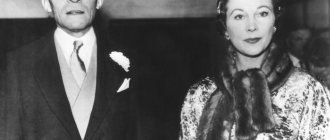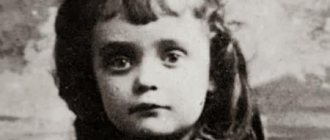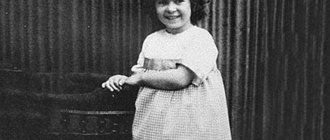Childhood and youth
The great writer was born in America, on the southwestern coast of Lake Michigan, not far from the cultural capital of the Midwest - Chicago, in the provincial town of Oak Park. Ernest was the second child of six children. The boy was raised by parents who were far from literary art, but wealthy: the popular performer Mrs. Grace Hall, who had retired from the stage, and Mr. Clarence Edmont Hemingway, who devoted his life to medicine and natural history.
It is worth saying that Miss Hall was a unique woman. Before her marriage, she delighted many cities in the United States with her sonorous voice, but left the singing field due to intolerance to stage light. After leaving, Hall blamed everyone for her failure, but not herself. Having accepted Hemingway’s marriage proposal, this interesting woman lived with him all her life, devoting her time to raising children.
But even after marriage, Grace remained a strange and eccentric young lady. Ernest was born until he was four years old in girls' dresses and with bows on his head because Mrs. Hemingway wanted a girl, but the second child was a boy.
In his free time, general practitioner Clarence loved to go hiking, hunting and fishing with his son. When Ernest was 3 years old, he got his own fishing rod. Later, childhood impressions associated with nature will be reflected in Hemingway's stories.
In his youth, Khem (the writer's nickname) voraciously read classical literature and composed stories. While at school, Ernest made his debut in a local newspaper as a journalist: he wrote notes about past events, concerts and sports competitions.
Although Ernest attended the local Oak Park school, his works often describe northern Michigan, a picturesque place where he went on summer vacation in 1916. After this trip, Ernie wrote a hunting story, “Sepi Zhingan.”
Among other things, the future laureate in literature had excellent sports training: he was fond of football, swimming and boxing, which played a cruel joke on the talented young man. Due to the injury, Hem was practically blind in his left eye and also damaged his left ear. For this reason, in the future the young man was not accepted into the army for a long time.
Ernie wanted to become a writer, but his parents had other plans for their son's future. Clarence dreamed that his son would follow in his father’s footsteps and graduate from medical school, and Grace wanted to raise a second Schubert or Beethoven, imposing on her child the music lessons he hated.
This mother’s whim affected Khem’s studies, as he missed a whole year of compulsory classes, studying the cello every day. “She thought I had abilities, but I had no talent,” said the elderly writer in the future.
After graduating from high school, Ernest, disobeying his parents, did not go to university, but began to master the art of journalism in the city newspaper of Kansas, The Kansas City Star. At work, police reporter Hemingway encountered such social phenomena as deviant behavior, dishonor, crime and the corruption of women; he visited crime scenes, fires, and visited various prisons.
However, this dangerous profession helped Ernest in literature, because he constantly observed the behavior of people and their everyday dialogues, devoid of metaphorical delights.
Literature
After participating in military battles in 1919, the classic moved to Canada and returned to journalism. His new employer was the editors of the Toronto Star newspaper, which allowed the gifted young man to write materials on any topic. However, not all of the reporter’s works were published.
After a quarrel with his mother, Hemingway took things from his native Oak Park and moved to Chicago. There the writer continued to collaborate with Canadian newspapermen and at the same time published notes in the Co-operative Commonwealth.
In 1821, after his marriage, Ernest Hemingway fulfilled his dream and moved to the city of love - Paris. Later, impressions of France will be reflected in the book of memoirs “A holiday that is always with you.”
There he met Sylvia Beach, the eminent owner of the Shakespeare and Company bookstore, which was located not far from the Seine. This woman had enormous influence in the literary circle, because it was she who published James Joyce’s scandalous novel “Ulysses,” which was banned by censors in the United States.
Hemingway also became friends with the famous writer Gertrude Stein, who was wiser and more experienced than Hem and considered him her student all her life. The extravagant woman disdained the creativity of journalists and insisted that Ernie be involved in literary activities as much as possible.
Triumph came to the master of the pen in the fall of 1926 after the publication of the novel “The Sun Also Rises” (“Fiesta”) about the “lost generation.” The main character Jake Barnes (Hemingway's prototype) fought for his homeland. But during the war he received a serious injury, which forced him to change his attitude towards life and women. Therefore, his love for Lady Brett Ashley was platonic in nature, and Jake healed his emotional wounds with the help of alcohol.
In 1929, Hemingway wrote the immortal novel “A Farewell to Arms!”, which to this day is included in the required list of literature for study in schools and higher educational institutions. In 1933, the master composed a collection of short stories, “The Winner Takes Nothing,” and in 1936, Esquire magazine published Hemingway’s famous work “The Snows of Kilimanjaro,” which tells about the writer Harry Smith, who is looking for the meaning of life while traveling on safari. Four years later, the war work “For Whom the Bell Tolls” was released.
In 1949, Ernest moved to sunny Cuba, where he continued to study literature. In 1952 he wrote the philosophical and religious story “The Old Man and the Sea,” for which he was awarded the Pulitzer and Nobel Prizes.
Behind every Hemingway book there is a woman
“He did it after all!”
- approximately this thought occurred to several women in different parts of the world at once when the world press reported: the great Hemingway committed suicide. This gray-haired handsome man was an irresistible man. While falling in love, I dreamed of marriage. Having got married, he began to feel burdened by family life and was looking for new love. He said: “I can only write when I’m in love.”
certificate "s.-i."
Ernest Hemingway (1899-1961) was a great American writer. Due to poor eyesight, he was not accepted into the army, so he enlisted in the American Red Cross. In 1918 he was wounded on the Austro-Italian front. After the war he became a correspondent for Canadian newspapers in Europe. Then he took up literary work, interrupting it only during the Second World War, again becoming a journalist. After the war he moved to Cuba and received the Pulitzer Prize in 1953 and the Nobel Prize in Literature in 1954. He was married four times and had sons - John, Patrick and Gregory. In recent years he suffered from severe depression, and on July 2, 1961, he shot himself in the forehead, just like his father in 1928.
A FAREWELL TO ARMS!
The sweet nurse from the Milan hospital where 19-year-old Hemingway was wounded was 7 years older. But it was she who became his first true love.
In his youth, he liked older women: two wives and two lovers were just like that. Only with age did he begin to pay attention to young girls. But that would come later, and in 1918 his attention was focused on Agnes von Kurowski. He asked her to marry, but for 26-year-old Agnes, the handsome 19-year-old was just a “nice boy.”
Agnes outlived her “bambino” by 23 years. And until the end of her life she kept and re-read his enthusiastic letters, which he bombarded her with for many years. And she adored the novel “A Farewell to Arms!” because the heroine Catherine Barkley was based on her.
A HOLIDAY THAT IS ALWAYS WITH YOU
Ernest's first wife was a woman eight years older than him. Hadley Richardson, a wonderful pianist, the future mother of his son John, had luxurious hair. He always attached special importance to beautiful hair on women.
For Ernest's birthday, Hadley gave the Crown typewriter: “I give you the Crown... There is a belief: a man marries a girl who gives him a crown.” The belief came true. And Hadley, the first of his many women, had to experience the difficult temper of her husband: living in abundance, he forced his wife to save on dresses. At times Hadley could not go out anywhere, her clothes were so shabby. With age, she gained weight, began to look like a matron, and the age difference became more and more obvious. Their marriage survived several of Hemingway's hobbies on the side. But they broke up anyway. And Hadley became the heroine of the novel “The Holiday That Is Always With You.”
AND THE SUN RISES
Duff Twoisden was called a femme fatale. She became a serious test for Hemingway's first marriage. Duff was successful with men; she drank equally with them at parties, but she was always in control of the situation. And only Ernest’s “sexual magnetism,” by his own admission, deprived her of this self-control. Duff did not dare to encroach on his family. But she became the prototype of the bright Brett Ashley in the novel “The Sun Also Rises,” as well as several of his stories.
GREEN HILLS OF AFRICA
Paulina Pfeiffer, a close friend of Hemingway's first wife, became his second wife. She was sporty and stylish. Hadley guessed about their connection and even suggested that they test their love by separating for 100 days. Alas, 100 days of separation only fueled Ernest and Paulina's love for each other. Hadley had to agree to a divorce. After marriage, trouble befell the new couple from an unexpected source. Hemingway had a strange peculiarity - after his marriage he began to have problems with potency: “I was fine in bed with Paulina during our affair, but after marriage I could no longer make love. Pauline was tolerant, we tried, but nothing worked.” Then everything went back to normal. Pauline gave birth to the writer two sons. But after 10 years, this marriage also cracked. After the divorce, she never married again, remaining forever in his book “The Green Hills of Africa” and others.
SNOW OF KILIMANJARO
In 1931, the writer met Jane Mason. They became lovers, indulging in crazy entertainment: drinking a glass of daiquiri, getting into their cars and racing around. We often got into accidents. Jane, loving Ernest, nevertheless did not recognize anyone's power over her. She went on safari to Africa with other men, he was jealous. And although they separated in 1936, Hemingway continued to monitor her fate. She became the prototype for his heroines in the short story “The Snows of Kilimanjaro” and the novel “The Short Happiness of Francis Macomber.”
FIFTH COLUMN
The marriage to Martha Gellhorn can be considered the most unsuccessful for Hemingway. Martha was a gifted writer and journalist. They were both first-class war correspondents, came under fire in Spain, lived in front-line hotels, and sometimes competed in finding information for their newspapers. For the first time, Hemingway encountered the woman he loved, who loved him, but did not want to sacrifice her calling. Their divorce proceedings took place in the absence of the spouses at the very end of 1945. He never met Martha again and did not exchange a single letter. But he immortalized it in the brilliant novels “The Fifth Column” and “For Whom the Bell Tolls.” By the way, in her memoirs she never remembered his name, except that she wrote “my friend is a journalist.”
BEHIND THE RIVER IN THE SHADOW OF TREES
But Mary Welsh, Hemingway’s fourth wife, left her profession, although she was considered a good journalist. Already at their first meeting, Hemingway said: “I don’t know you, Mary, but I want to marry you.” They lived together for 16 years. This was the writer's longest marriage. Their intimate relationship turned into a carnival. Even while flirting with other women, Hemingway admitted that “as a sexual partner, Mary is superior to everyone.”
When the fatal shot was fired, Mary remembered that Ernest, speaking of his father, who committed suicide, often repeated: “I will most likely do the same.” After the death of her husband, she returned to her profession, published a book of memoirs, “How It Was,” and worked on the literary heritage of her husband.
GARDEN OF EDEN
Hemingway's great love was the Italian Countess Adriana Ivancic. He even proposed marriage to her while he was married to Mary Walsh.
Among those who captured the writer's heart was Nancy Hawkes, a former model, a tall, beautiful blonde who was almost 20 years younger than him.
Sexy actress Jig Virtel repeatedly tried to get Hemingway, promising him a ranch in California, a stud farm and all the opportunities for creativity if he left his wife.
But Hemingway's last love was 19-year-old journalist Valerie Denby-Smith. Mary Walsh was seriously jealous of her husband only for Valerie. Without becoming “Mrs. Ernest Hemingway,” Valerie nevertheless took on this surname by marrying his son, Gregory.
These women are remembered because they were in Hemingway’s life and remained in his works - “The Old Man and the Sea”, “The Garden of Eden” and others.
Personal life
The personal life of Ernest Hemingway was so replete with all sorts of events that a whole book would not be enough to describe the adventures of this great writer. For example, the master was a thrill-seeker: at a young age he could “rein in” a bull by participating in a bullfight, and was also not afraid to be alone with a lion.
It is known that Hem adored the company of women and was amorous: as soon as a girl he knew showed her intelligence and graceful manners, Ernest was immediately amazed by her. Hemingway created for himself the image of a certain Marquis de Sade, talking about how he had many mistresses, ladies of easy virtue and black concubines. Whether this is fiction or not, biographical facts say that Ernest really had many chosen ones: he loved everyone, but called each subsequent marriage a huge mistake.
Ernest's first lover was the lovely nurse Agnes von Kurowski, who treated the writer in the hospital for his wounds during the First World War. It was this light-eyed beauty who became the prototype of Catherine Barkley from the novel “A Farewell to Arms!”
Agnes was seven years older than her chosen one and had maternal feelings for him, calling him “baby” in her letters. The young people thought of legitimizing their relationship with a wedding, but their plans were not destined to come true, as the flighty girl fell in love with a noble lieutenant.
The second chosen one of the literary genius was a certain red-haired pianist Elizabeth Hadley Richardson, who was 8 years older than the writer. She may not have been a beauty like Agnes, but this woman supported Ernest in every possible way in his activities and even gave him a typewriter. After the wedding, the newlyweds moved to Paris, where at first they lived from hand to mouth. Elizabeth gave birth to Hema's first child, John Hadley Nicanor ("Bumby").
In France, Ernest often visited restaurants where he enjoyed coffee in the company of his friends. Among his acquaintances was the socialite Lady Duff Twisden, who had high self-esteem and did not disdain strong words. Despite such provocative behavior, Duff enjoyed the attention of men, and Ernest was no exception. However, at that time the young writer did not dare to cheat on his wife. Twisden was later "recast" as Brett Ashley from The Sun Also Rises.
In 1927, Ernest began to become involved with Pauline Pfeiffer, Elisabeth's friend. Paulina did not value her friendship with the writer’s wife, but on the contrary, she did everything to win someone else’s man. Pfeiffer was pretty and worked for the fashion magazine Vogue. Later, Ernest will say that a divorce from Richardson will be the greatest sin of his entire life: he loved Paulina, but was not truly happy with her. From his second marriage, Hemingway had two children - Patrick and Gregory.
The third wife of the laureate was the famous US correspondent Martha Gellhorn. The adventurous blonde loved hunting and was not afraid of difficulties: she often covered important political news happening in the country and did dangerous journalistic work. Having achieved a divorce from Paulina in 1940, Ernest proposes to Martha. However, soon the newlyweds’ relationship “came apart at the seams,” since Gellhorn was too independent, and Hemingway loved to dominate women.
Hemingway's fourth betrothed is journalist Mary Welsh. This radiant blonde supported Ernest’s talent throughout the marriage, and also helped with publishing efforts, becoming her husband’s personal secretary.
In 1947 in Vienna, a 48-year-old writer falls in love with Adriana Ivancic, a girl 30 years younger than him. Hemingway was attracted to the white-skinned aristocrat, but Ivancic treated the author of the stories like a father, maintaining friendly relations. Mary knew about her husband’s hobby, but she acted calmly and wisely as a woman, knowing that the fire that arose in Hemingway’s chest could not be extinguished by any means.
Meeting of the famous writer Ernest Hemingway and a Hollywood actress
The fateful Marlene Dietrich met while traveling on an ocean liner. As Marlene recalled as a result, love happened at first sight and remained forever. And it was all the same that correspondence replaced meetings. As Ernest said, he and Dietrich loved each other very much, but never woke up together.
Barbados announces one-year remote work visa for $2,000-$3,000
My husband made a desktop from boards from an old pallet: step-by-step instructions
New trade rules could spark a textile boom in Europe
Their meetings were very rare; Marlene considered the time spent without Hemingway to be a pain. But communication with the American writer has always been an inexplicable mystery for Dietrich. Their relationship remained platonic. Ernest Hemingway and Marlene Dietrich were closer in soul than the most passionate lovers.
Death
Fate constantly tested Ernest's resilience: Hemingway survived five accidents and seven catastrophes, and was treated for bruises, fractures and a concussion. He also managed to recover from anthrax, skin cancer and malaria.
Shortly before his death, Ernest suffered from hypertension and diabetes, but was admitted to the Mayo Psychiatric Dispensary for “cure.” The writer’s condition only worsened, and he also suffered from manic paranoia about being watched. These thoughts drove Hemingway crazy: it seemed to him that every room wherever he was was equipped with bugs, and vigilant FBI agents were on his heels everywhere.
The clinic doctors treated the master in the “classical way”, resorting to electroconvulsive therapy. After 13 sessions, therapists made it impossible for Hemingway to write because his vivid memories had been erased by electric shock. The treatment did not help, Ernest plunged deeper into depression and obsessive thoughts, talking about suicide. Returning to Ketchum on July 2, 1961, after being discharged, Ernest, thrown “to the margins of life,” shot himself with a gun.
Facts from Hemingway's life
- The future writer received his name in honor of his grandfather.
- Ernest Hemingway's parents were wealthy people who lived in a 7-room private house in a prestigious area. His father was a successful doctor, and his mother was an opera singer.
- As Hemingway grew up, he repeatedly said that he did not like his name because he associated it with the hero of one of Oscar Wilde’s plays, a naive and stupid person.
- His mother dressed young Ernest Hemingway like a girl, and even cut his hair for the first time only when he was 6 years old.
- Hemingway once said in an interview that he hated his mother.
- As a child, he was forced to learn to play the cello, even though he had no musical talent.
- When Hemingway was 4 years old, his father began teaching him to hunt and fish. This had an impact on the writer’s entire life - he loved traveling to remote places, far from civilization.
- Ernest Hemingway had a very warm relationship with his grandfather. When the future writer turned 12 years old, he even gave him a hunting rifle.
- Hemingway's father committed suicide by shooting himself with a hunting rifle.
- As a child, Ernest Hemingway wrote notes and articles for the school newspaper. These were his first publications.
- After the outbreak of World War I, Hemingway wanted to volunteer for the front, but was rejected by the draft board due to a problem with his left eye.
- Health problems did not stop the writer, and he signed up as a volunteer driver for the Red Cross, going to Italy. There he helped search for and rescue the wounded, despite his injuries, for which he received the Italian Medal of Courage.
- Throughout his life, Ernest Hemingway came close to death many times. He was involved in more than ten accidents and disasters, was wounded twice while hunting, almost burned out in a forest fire, and in battle was wounded by a machine gun fire and received 273 mine fragments in his body.
- Hemingway's bullet-shattered kneecap was replaced with an aluminum prosthesis, causing him to limp for the rest of his life.
- During the war, Hemingway met Antoine de Saint-Exupery, who was already a famous writer.
- One day he won a bet on the shortest and most touching story, creating it from 6 words and winning. Since then, ultra-short story competitions have been held all over the world.
- Ernest Hemingway loved cats, of which he had more than 20. He once had to shoot his cat, which was hit by a car, to end its suffering, and he recalled this episode as one of the most difficult in his life.
- On the fronts of World War II, Hemingway was a war correspondent. He was almost put on trial for violating the Geneva Convention, according to which correspondents do not have the right to take up arms, which did not stop the writer from once opening fire on a German detachment with a machine gun. Subsequently, the matter was hushed up.
- The descendants of Snowball, Hemingway's beloved cat, who had 6 toes on his paws, now live in his house-museum in the USA. There are more than 40 of them, and most of them also have 6 toes. They are recognized as a US national treasure.
- Ernest Hemingway hated giving autographs, and few people were able to get them, which is why they were especially highly valued by fans of his work.
- The writer was terrified of speaking in public. Moreover, he repeatedly stated that he did not believe the sincerity of the praise of readers and critics.
- During his lifetime, Hemingway became famous for his recklessly brave actions - he participated in bullfights, entered a cage with lions, and entered the ring with the US boxing champion.
- He received his Nobel Prize in Literature for his philosophical story “The Old Man and the Sea.”
- Fans of Hemingway's work around the world affectionately call him "Papa Ham."
- In the 30s of the last century, an impostor posing as Hemingway traveled around the United States. He created scandals, signed autographs and wrote out bills in the name of the writer. He tried to catch him, but he failed.
- Ernest Hemingway's work was banned in Germany during the reign of Hitler and in Italy during the reign of Mussolini.
- In 1978, a Soviet astronomer discovered a minor planet named after Hemingway.
- One day, the writer tore out of the wall and stole a urinal from his favorite bar, where he had been a regular for many years. He stated that he left so much money there that the urinal now belongs to him. The bar owner did not object.
- Having acted as the author of the script for the film “Spanish Land,” Hemingway used all the proceeds from this work to purchase ambulances for the Spanish Republican Army.
- The writer's father, brother, sister and granddaughter also committed suicide.
- Once an annoying fan followed Hemingway for 3 months to get an autograph. He finally got it - the writer wrote to him "Victor Hill, a real son of a bitch who can't understand the word 'no'."
War
Hemingway was interested in the war and wanted to participate in it, but due to vision problems (his left eye was damaged), he was not accepted.
But the writer was able to get to the front of the First World War in Italy. There he drove a Red Cross vehicle. The events taking place during the war prompted Hemingway to write the book “A Farewell to Arms!”
In 1918, the writer came under fire while rescuing an Italian sniper, who was wounded but miraculously survived. At the hospital, 26 fragments were removed from Ernest, and in Milan, doctors replaced his kneecap with an aluminum prosthesis.









